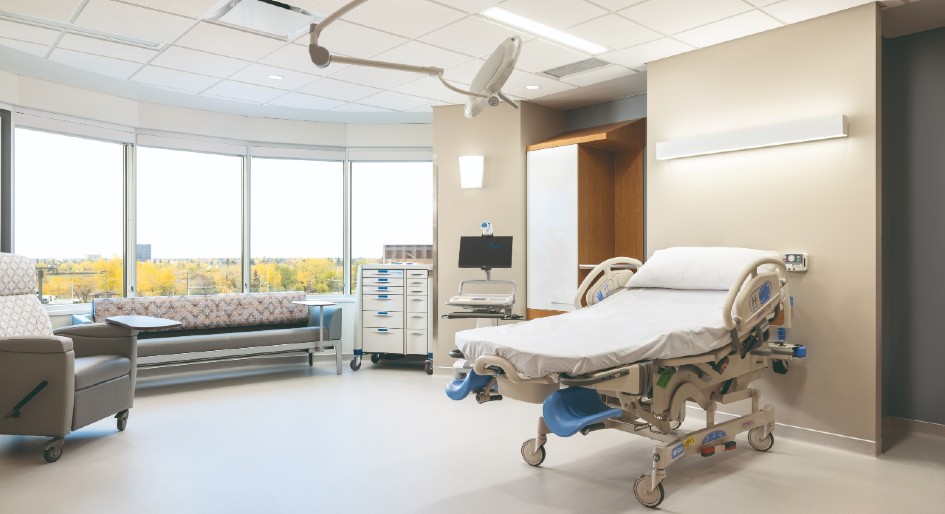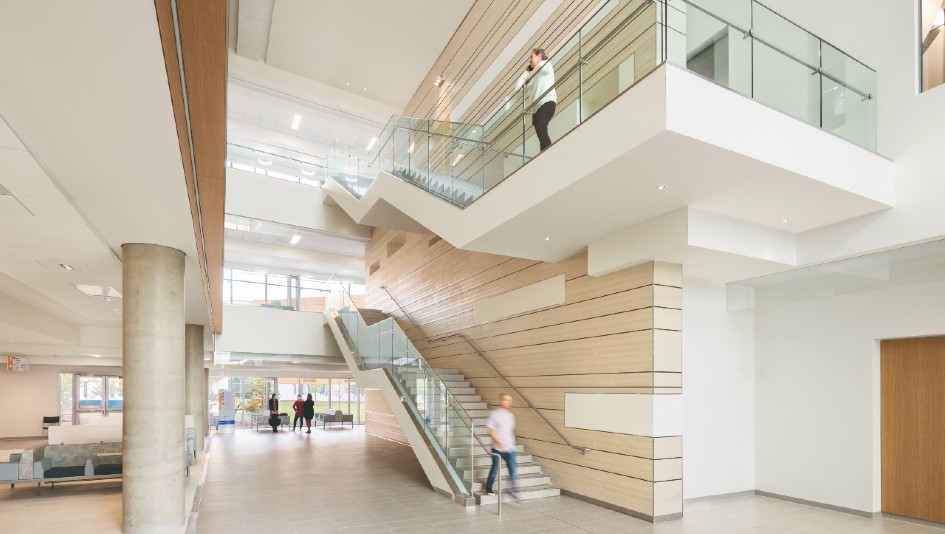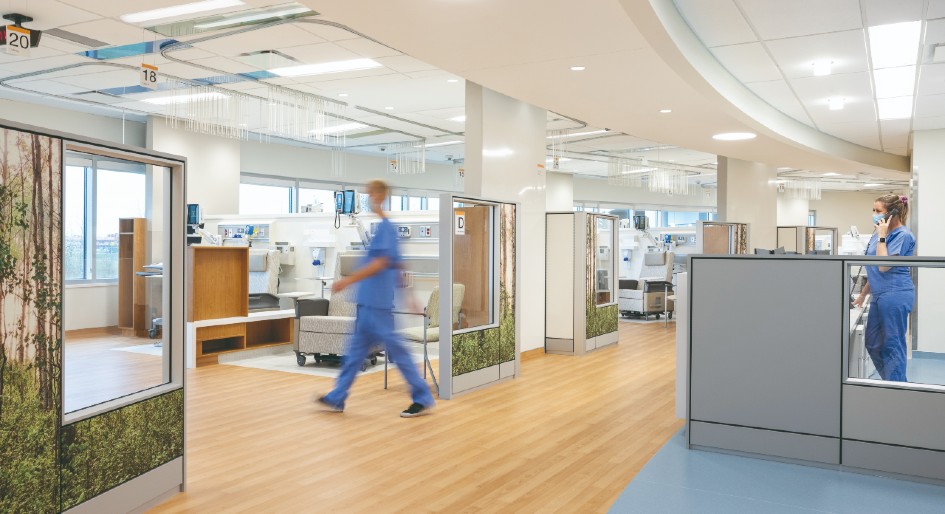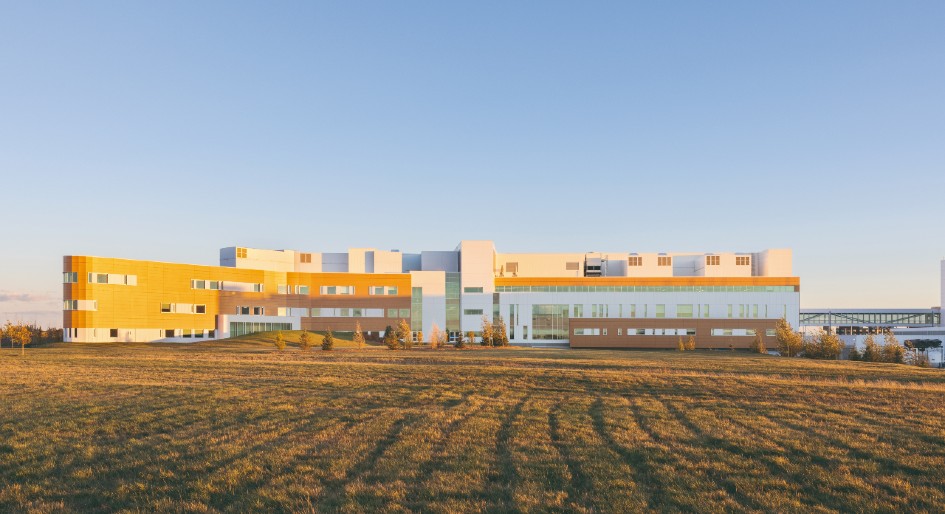Outside Grande Prairie Regional Hospital, a therapeutic walking path links to the Muskoseepi Trail that meanders through the small city for miles. The structure’s curvy linear form follows the flow of Bear Creek that lies adjacent to the 30-acre site. Through windows of the patients’ rooms, wildlife can be seen wandering along the water’s edge—foxes, deer, coyotes.
As the trail’s northwest anchor point, the hospital, designed by DIALOG, and its surrounding green space is the heart of the community, uniting passersby as well as the patients inside. “It becomes a destination,” says Adrian Lao, a partner at DIALOG. “Even when you’re sick and unable to go outside, you can be part of the community; you can be part of the beautiful surroundings. You don’t feel as though you’re losing that connection.”
Inside the 681,000-square-foot facility, people are able to experience the landscape and natural light, even throughout Alberta’s harsh weather extremes, where winters can dip below -50 degrees and rise higher than 40 degrees in summer. As Lao explains, wide-shaped in-patient units create two internal courtyards and surround them on all four sides, creating a cloistered space that is outdoors yet sheltered from the wind.
“People can see beautiful views of the courtyards while they are inside the inpatient beds, so they feel a sense of community,” he says. “If the weather is warm or sunny, they can also be in the courtyard without having to feel the strong westerlies that blow there all the time.”
Throughout the 240-bed hospital, the outside flows into the interior as one unified aesthetic, with a warm wood look for doors and paneling, materials that bring a sense of comfort so people feel as if they’re in their own bedrooms. All rooms are single-patient with personal bathrooms. The design of the walls keep everything quiet. “One of the best things we can do for a patient to heal is to allow them to sleep peacefully with privacy and dignity and security,” says Lao.

A single-patient room overlooks the prairie landscape. Photo by Klassen Photography.
The layout allows for deep daylight penetration into all the care and treatment rooms, and is just one reason why the hospital was recently honoured with an International Building Award from the International Federation of Healthcare Engineering.
And it’s been a long journey to that moment. The project began in 2011 and finished in 2020, with 99 patients relocating from Queen Elizabeth II hospital as it no longer provides acute and inpatient care. The hospital officially opened this past February, but the process took longer than expected due to a delay in construction and the struggle to find labour. Out-of-town workers travelled in from Edmonton and Calgary to finish the work.
“This was also the largest project of its type and quite complex so we needed to explain the project to the authorities,” says Lao. “But we had wonderful support from the mayor of
Grande Prairie throughout the approvals process.”

The main lobby. Photo by Klassen Photography.
The design team created a ‘shared vision’ with Alberta Health Services, the city and the community. “When you have the community excited about what you’re trying to do, it’s wonderful because you have the wind on your back; the wind is filling your sails,” says Lao.
Part of that vision was making the space warm and inviting, open to community events and celebrating life in Grande Prairie, so it’s more than a place to go when one is sick.
And for those who are unwell, an array of healthcare services can be found: outpatient ambulatory care, emergency, diagnostics, obstetrics, surgery, pediatrics, acute geriatrics, mental health, and intensive care. A much-anticipated cancer centre serves patients undergoing chemotherapy who might otherwise have to travel to Edmonton and is also a first in the Alberta Health Services North zone to offer radiation therapy.

Biophilic elements in the infusion bays in the cancer clinic. Photo by Klassen Photography.
A Dignified Design for Grande Prairie
As the hospital came together, the accessibility of mental health care figured prominently into the design, with various components catering to different age groups with particular needs.
The unit is separated into three pods—youth, adults and seniors—to make it easier for staff to care for patients. For instance, a geriatric population may be struggling with mental health alongside chronic diseases and mobility issues.
“Every case is different, but where possible, we have doors that interlink and open for shared social programs and communal dining,” says Lao. “We designed it in such a way that is flexible with care delivery but respects the needs of these three populations, and we allow it to be done safely but together.
A mental health garden is a therapeutic place for patients to rest—to feel the sun and fresh air, in a secure yet non-oppressive way. Unlike barbwire penitentiary-style fences, Lao says the fencing system was designed to be safe and non-climbable, yet look aesthetically pleasing, as though it almost disappears.
“The patients love feeling like they’re in a dignified environment,” he adds. “They feel like they’re part of the community, as if they’re being cared for and nurtured without being ostracized.”
A Hospital Within A Hospital
For a city with a young and growing population of families, a large obstetrics hospital was designed within Grande Prairie Regional Hospital. The rooms are designed as a “one-stop resting place” for labour, delivery and postpartum recovery.
“Kind of like a hotel suite,” says Lao. The walls shield outside noise; each room is private with a personal washroom and family space. An operating room is located within 20 feet in case of an emergency C-section. A level 2-plus neonatal intensive care unit is also designed immediately adjacent to the mother
“The whole paradigm has been reversed so the centre of focus is the patient, the baby and families,” he adds. “This is a fundamental change in the way care is delivered. The idea is to make the experience as therapeutic, nurturing, dignified and secure as possible for mother and baby.”
This patient-focused approach, where hospitals are comforting places to heal, with minimal noise, more privacy and access to the outside is where Lao sees the future of healthcare heading–that, along with reducing energy use and achieving net zero, as well as going beyond universal design, where a standardized approach might not be sensitive to the peculiar needs of every community.
“If you can design an environment that way and respect the community you are doing it for. . . and make it unique—something the whole community can get behind and be proud of, and staff and patients feel comfortable going there, then you will have made the hospital a truly meaningful place for healing,” he says. “The hospital is ultimately for the communities we design for; it’s about them, and it’s for their future.”

The Alberta landscape is accessible from all patient windows. Photo by Klassen Photography.





